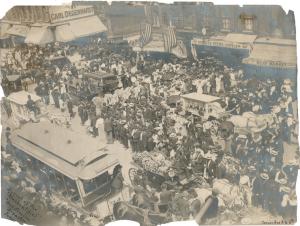Millions of German immigrants arrived in the United States during the nineteenth century and established a thriving community on the Lower East Side of Manhattan. On June 15, 1904, thirteen hundred members of St. Mark’s Lutheran Church boarded the steamboat General Slocum at the East Third Street pier for an outing to Locust Grove on Long Island.
As the ship headed up the East River, a fire broke out, engulfing the wooden steamboat as it sped into the wind. Faulty life jackets increased the number of deaths to between 800 and 1200 people - New York City’s deadliest tragedy before September 11th. Many bodies were burned beyond recognition. This photograph depicts a gathering of mourners burying the unidentified dead.

Burial of the ‘unidentified’ ‘Gen. Slocum’ disaster June [15, 1904] : Corner Ave. A & 6th St. Gustav Scholer papers. / Series XI. Photographs. New York Public Library.
The General Slocum disaster decimated St. Mark’s membership and caused many families of German ancestry to leave the neighborhood “so intimately linked with the death of their loved ones,” writes historian Edward O’Donnell.
The number of German residents of Kleindeutschland decreased in the 1890s, but the General Slocum disaster accelerated this trend because the vast majority of the victims lived within a forty-block area.
Today you can visit a memorial of this tragedy in Tompkins Square Park, located in the neighborhood that was once called Kleindeutschland.
- Posted by Penny King

No comments:
Post a Comment
Note: Only a member of this blog may post a comment.